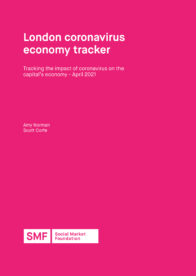This report, the fifth in a series commissioned by Peabody, updates our analysis of the impact of COVID-19 on London's economy. It explores the latest timely data on economic outcomes to produce an as up-to-date picture as possible.
- The latest claimant count data show unemployment increasing in both London and the UK as a whole, with a more rapid increase in the capital. Between the end of last year (December 2020) and March, the number of people claiming unemployment-related benefits in London has increased by 4.9%, higher than the 3.8% seen for the rest of the UK. This amounts to an increase in unemployment of about 24,000 in the capital.
- Compared with February 2020, before the UK entered the first coronavirus lockdown, the claimant count in London has soared by 178%, far higher than the 104% seen in the rest of the country.
- Newham was the London borough which saw the biggest increase in unemployment between December 2020 and March 2021. There, the claimant count increased by 1,905 over this time period. Kingston-upon-Thames, Richmond-upon-Thames and the City of London saw the smallest increases in unemployment.
- The number of job vacancies in London has continued to recover in recent weeks, to stand at just under 170,000 openings. This is about 60% more job vacancies than at the end of 2020, though the number of vacancies remains 14% lower than in mid-March 2020, before the first coronavirus-related lockdown. In contrast, in the rest of the UK, the number of job vacancies is now 19% higher than in mid-March 2020.
- While growth in the number of job vacancies in London raises the prospect of an improving labour market as lockdown gradually eases, there is likely to be a significant skills mismatch between the newly jobless, and the types of job vacancies available. While sectors such as retail and hospitality have seen the most coronavirus-related job shedding, most vacancies in the capital are in relatively higher-skill sectors such as IT, finance and education.
- SMF analysis of the Understanding Society survey shows that, during the pandemic, Londoners are much more likely to have been always working from home – suggesting the capital is most exposed to the implications, both positive and negative, of more remote working. 39% of working Londoners in September 2020 were always working from home, compared with 19% across the UK as a whole.
- Reduced commuter footfall, tourism and the shift towards online shopping could lead to significant job losses in “face-to-face” industries such as retail, hospitality and arts & culture over the coming years. We estimate that such sectors prior to the pandemic accounted for over 800,000 jobs in Central London, with the borough of Westminster particularly exposed to these trends in terms of absolute number of face-to-face jobs.

Download The Report: PDF
Kindly sponsored by

